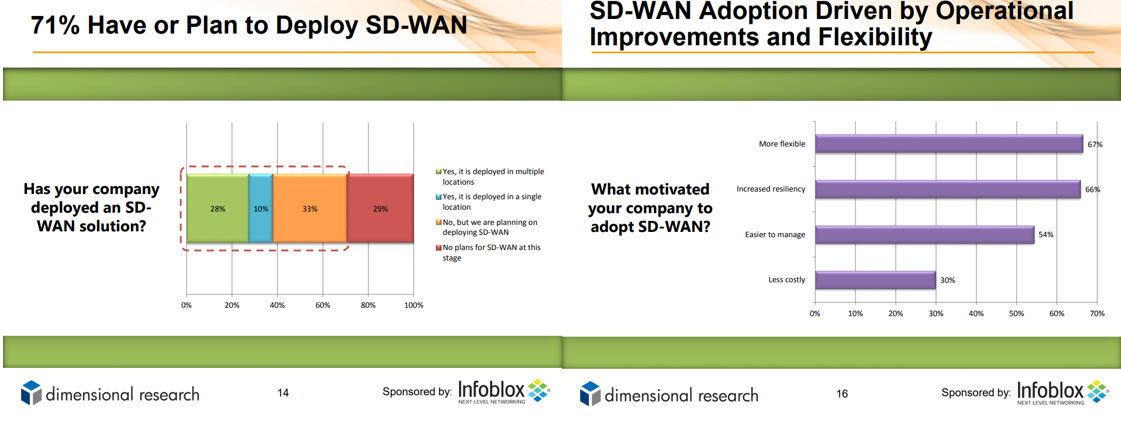
- 93% of enterprises are securing remote locations with a centralized approach that rarely scales to secure every endpoint and identity of remote branch locations, leaving an enterprise more vulnerable to a breach.
- Enabling network security is the greatest challenge enterprises face when managing a highly distributed network with numerous remote locations.
- In an era of cloud-first networks, 9 out of 10 companies are still relying on centrally managed networks that don’t scale for remote system users, creating productivity bottlenecks.
- 75% of enterprises experience branch and remote location network interruptions several times a year or more frequently, costing an organization thousands of dollars an hour in lost productivity.
The challenges of scaling cloud services to grow a digital business are many and are well-explained in the recent research report, Remote Office Networks Pose Business and Reliability Risk A Survey of IT Professionals (27 pp., PDF, no opt-in), published on August 2019 by Dimensional Research in collaboration with Infoblox. This report provides valuable insights into why scaling cloud services is essential for growing a digital business. The study’s findings reflect how remote branch and production locations’ lack of IT security and site personnel are one of the most challenging constraints to overcome and keep growing their business. Please see page 22 of the study for specifics on the methodology.
99% or nearly all enterprises with distributed operations suffer adverse business impacts from network interruptions. Of the many causes of network disruption, one of the most common is not directing traffic to the closest point of entry into cloud platforms. Taking a software-based approach to wide-area networking (SDWAN) is proving effective in improving cloud-based application performance, including Microsoft Office 365 cloud-based application performance. The report shows how SD-WAN is replacing outdated centralized IT models that lack the scale to flex and support new digital business models.
Key insights from the research report include the following:
- Enterprises realize the model of relying on centralized IT security isn’t scaling to support and protect the proliferation of user devices with internet access, leaving branch offices less secure than ever before. Every IT architect, IT Director, or CIO needs to consider how taking an SDWAN-based approach to network management reduces the risk of a breach and data exfiltration. 93% of enterprises are securing remote locations with a centralized approach that rarely scales to secure every endpoint and identity of remote branch locations, leaving an enterprise more vulnerable to a breach. Enterprises are upgrading their core network services, including DNS, DHCP, and IP address management, on cloud-based DDI platforms to bring greater security scale and reliability across their enterprise networks. Enterprises are also devising Zero Trust Security (ZTS) frameworks to secure every network, cloud, and on-premise platform, operating system, and application across their branch offices. Chase Cunningham of Forrester, Principal Analyst, is the leading authority on Zero Trust Security, and his recent video, Zero Trust in Action, is worth watching to learn more about how enterprises can secure their IT infrastructures. You can find his blog here.
- 75% or the majority of an enterprises’ branch offices experience network interruptions several times a year, with 49% of them requiring three or more hours to resolve remote office network outages. Enterprises continue to pay a very high price in lost productivity due to network interruptions and the time it takes to troubleshoot them and get a branch or remote location back online. Enterprises are upgrading their core network services, including DNS, DHCP, and IP address management, on cloud-based DDI platforms to bring greater scale and reliability across their enterprise networks. Cloud-based DDI platforms enable enterprises to manage networking for hundreds to thousands of remote sites with unprecedented cost-efficiency.
- Relying on centralized IT creates many challenges and security threats for remote offices, with the most costly not having IT staff at remote sites. Network security at remote locations is the greatest challenge enterprises face when managing a highly distributed network with numerous remote locations. A contributing factor to security being the leading challenge of managing a highly distributed network is the lack of IT employees at remote branches. 65% of enterprises are routinely sending IT employees to remote branches to resolve networking issues alone. Travel costs combined with lost productivity from having to send IT technicians out for a week or longer to solve network performance issues is another reason why enterprises are adopting cloud-based DDI platforms.
- Enterprises are adopting cloud-based DDI platforms that enable enterprises to simplify the management of highly distributed remote networks as well as to optimize the network performance of cloud-based applications. Dimensional Research’s study reflects how enterprises are meeting the challenge of increasingly complex, distributed networks that have a proliferating number of remote locations and endpoints. The majority of enterprises, 71%, are looking to integrate core network services, DNS, DHCP, and IP address management, into a single cloud-based DDI platform. The problem is, conventional DDI solutions for branch locations are too slow or complicated for a cloud-first world. The following graphic from the study shows what motivating enterprises to adopt SD-WAN today is.



